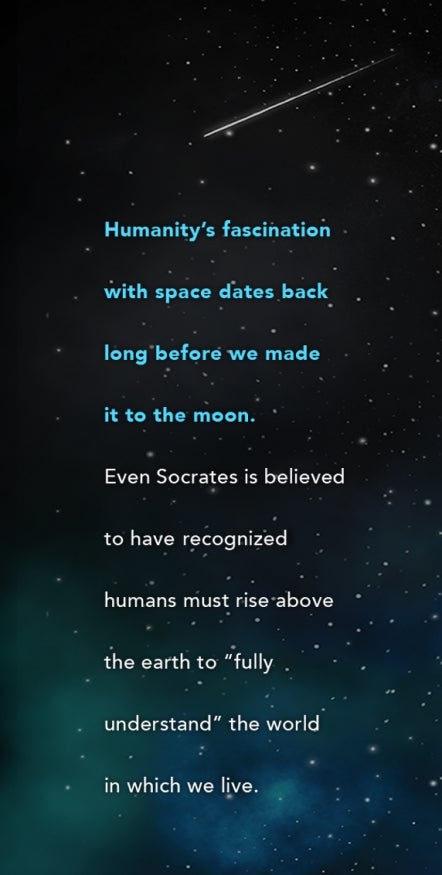

Preparing for Another Moonshot
by Torie Wells
In Mark Low’s office hangs a well-known image, a photo of an illuminated Earth rising over the rocky surface of the moon. The iconic photo taken from Apollo 8 — the first manned mission to orbit the moon — is a simple, yet powerful, reminder of the vastness of the universe and the significant knowledge there is yet to discover. It also makes a potent statement about the possibility of mankind. “Without risk, there can be no progress,” read the words printed on Mark Low’s copy. It’s a phrase he heard his father, George Low ’48, speak often, one that was a guiding tenet behind an incredible chapter of scientific progress.
The year was 1969, and the Low family lived in Texas. George Low had been appointed head of the Apollo Spacecraft Program Office at the Manned Spacecraft Center in Houston two years earlier, after the deadly Apollo 1 fire that claimed the lives of three astronauts. He understood deeply the responsibility of this role.
“He got into every single nut, bolt, and circuit in the spacecraft to understand failure modes, redundancies, safety,” says Mark Low, M.S. ’78, the eldest of five children born to George and Mary Low. “A lot of the success going forward, I think, is attributed to that level of detail.”
Mark Low remembers the long days and endless hours that his father was putting in leading up to, and following, the Apollo 11 launch. In 1969, Mark Low was about to be a senior in high school. He was also about to have a front-row seat to revolutionary moments in space that would captivate the world.

“I actually had an opportunity to go to the launch,” he says. “I watched the launch of Apollo 11, and then I remember being home during the flight and watching all the coverage on TV.”
“The moon landing was a pivotal moment, not only in our nation’s history, but also in growing the next generation of scientists and engineers. What we learned from the moon continues to fuel research today, including research at Rensselaer,” says President Shirley Ann Jackson. “Even larger than that, it showed us that ‘moonshots’ are possible.”
“I was 13 years old when the landing took place and I watched it on TV in black-and-white with everybody else that I knew,” says Curt Breneman, dean of the School of Science. “It showed me what science and engineering could do, and I wanted to be a scientist. I wanted to work on things larger than myself.”
At the time, Mark Low recognized the magnitude of the challenge — especially after the Apollo 1 fire. But it wasn’t until later, he says, that he fully appreciated his father’s role in conceiving, and making possible, the successful mission to bring man to the moon.
“He never drew attention to his role in it. He just did his work,” Mark Low says. “As amazing as it was, when you look back on it, it was an engineering and a program challenge that engineers tackled, and engineers achieved.”
George Low’s engineering roots can be traced back to Rensselaer, where in 1948 he earned his bachelor’s degree in aeronautical engineering. Two years later, he also received his master’s degree from Rensselaer.
At his core, Mark Low says, his father was a thorough and dedicated engineer who lived by the mantra, “pay attention to detail.”

“Paying attention to detail, being thorough, understanding in-depth, having the knowledge, were things he learned at RPI that really shaped the things he accomplished later. I really believe that,” he says.
That attention to detail garnered trust, especially among those George Low was responsible to protect. Mark Low remembers meeting Apollo 11 Astronaut Neil Armstrong years after the flight. The national hero referred to George Low as his favorite engineer.
In 1976, after nearly 30 years working for NASA and its predecessor, NACA, George Low returned to Rensselaer, this time as the Institute’s 14th president.
Not long after, his son had a chance to see his father in this new role firsthand, as Mark Low attended Rensselaer to earn a master’s degree in technical writing.
“To watch him in that environment, and to watch how he engaged and interacted with students — which I think did a lot of motivating based on the kinds of discussions he had — it was very rewarding,” he says.
In his time as president of Rensselaer, George Low’s focus on research provided the support the Institute needed to position itself as a nationally renowned university and educate the next generation of space explorers. He brought together academia, government, and the private sector to leverage collaborative progress.
That legacy continues, as Rensselaer and the nation look to return to the moon.
“It’s very interesting to be working on lunar navigation and lunar exploration 50 years after the Apollo program,” says John Christian, assistant professor of mechanical, aerospace, and nuclear engineering. “Working through all the challenges of achieving that task gives all of us in this field a deep appreciation for how difficult it must have been.”
Christian’s research is aimed at making autonomous space navigation possible — a critical component for humans to explore new areas of space, and safely make it back to the moon.
But unlike 50 years ago, engineers are now using modern technology, like digital cameras and modern computers, to take measurements and make calculations that the crew would need in order to navigate back to Earth if ground support could not help. Before, that all had to be done manually with a space sextant.
“My group is working on the topic of optical navigation,” Christian says. “Not only are these autonomous digital systems less cumbersome for the crew, but they are also generally more accurate.”
On the Rensselaer campus, student and faculty research continues to demonstrate how intrinsically linked the Institute is to the history of space exploration.
Kurt Anderson, professor of mechanical, aerospace, and nuclear engineering, is designing a trash collector for space — aptly named OSCaR, or Obsolete Spacecraft Capture and Removal — to tackle the growing and dangerous challenge of space debris.
Cynthia Collins, associate professor of chemical and biological engineering, Joel Plawsky, professor and head of the department of chemical and biological engineering, and Jonathan Dordick, the Howard P. Isermann Professor of Chemical and Biological Engineering, sent microorganisms into space. The team investigated ways to prevent the formation and spread of clusters of bacteria, known as biofilms. This research is key to understanding and mitigating risks astronauts may face during long-term space flights.
Amir H. Hirsa, professor of mechanical, aerospace, and nuclear engineering, is the latest faculty member to send an experiment into space. His approach to studying mixing and fluid stress without a container is one-of-a-kind. He’s applying that method to researching protein aggregation, laying the groundwork for greater understanding of the amyloids associated with neurodegenerative diseases like Alzheimer’s and Parkinson’s, as well as other diseases like diabetes.
Heidi Jo Newberg, professor of physics, applied physics, and astronomy, studies the structure of the Milky Way, using the location and movement of stars to map the galactic halo and disk. Her work contributes to our understanding of how our galaxy formed and can also be used to determine where dark matter may be located in the galaxy.
Joel Plawsky, professor and head of the department of chemical and biological engineering, and professor emeritus Peter Wayner have sent a series of wickless heat pipes to the International Space Station. Heat pipes have no moving parts and make ultra-reliable devices for cooling critical life support and electronic systems on spacecraft. The duo is studying how the absence of gravity affects the fluid dynamics and heat transfer in these devices. The research is key to designing more efficient and higher capacity heat transfer systems for long-duration space missions.
Karyn Rogers, assistant professor of earth and environmental sciences, is part of a new NASA consortium working to identify what planetary conditions may have given rise to life on Earth. Rogers leads the newly established Rensselaer Astrobiology Research and Education (RARE) Center which is supported, in part, by a $9 million grant from NASA.

Alumni Prepare for a Second Moonshot
Making it back to the moon remains a true engineering challenge. The parallels between the 1960s and now aren’t lost on Kat Coderre ’06, a systems engineer at Lockheed Martin.
“They did just amazing things and the whole nation rallied around, which is a true inspiration,” Coderre says. “To be able to get back to the moon, and really try and do it so we can set up something that’s more sustainable, that’s really the goal this time around.”
What’s different about today’s charge is that NASA wants to get humans back to the moon to stay, she says, so we can learn more about the astronomical body. Safety is a huge consideration, just as it was five decades ago.
“Space has become an exciting frontier again,” says Shekhar Garde, dean of the School of Engineering. “A lot of research in the area of space eventually helps humanity in other ways.”
Coderre agrees that we can learn a lot from space, a lot from the moon. And she feels enthusiasm building.
“There is that kind of worldwide excitement that’s starting to gain momentum,” she says. “I was able to find a good spot and be lucky enough to have a hand in this adventure.”
Humanity’s fascination with space dates back long before we made it to the moon. Even Socrates is believed to have recognized humans must rise above the Earth to “fully understand” the world in which we live.
That pursuit of understanding, about our universe and ourselves, has driven Rensselaer researchers, alumni, and students for at least the last 50 years.
Rensselaer alumni have played an influential role in the design and launch of the Mars rovers. They also have a long and continuing tradition of advancing space research at organizations such as NASA, SpaceX, Boeing, Lockheed Martin, and Blue Origin.
“Rensselaer has played a very direct and seminal role in the continuation of space exploration,” says President Jackson. “Because we educate primarily engineers and scientists, we create the overall foundation that one has to build upon in order to have a successful program.”
The continued spirit of curiosity, courage, and scholarship at Rensselaer would make his father proud, Mark Low says.
“I think he would have been very pleased with that legacy that is partially attributable to his time there and what’s happened since.”
Marta Bohn-Meyer ’79 became the first female crewmember for NASA assigned to the triple-sonic SR-71 Blackbird aircraft.
Kobie Boykins ’96, a senior mechanical engineer at NASA’s Jet Propulsion Laboratory, has played a key role in the design of three Mars rovers.
Kat Coderre ’06 is a staff systems engineer for Lockheed Martin in the Advanced Programs Group within the Commercial Civil Space area.
Rick Mastracchio ’87 conducted nine spacewalks during three shuttle flights and a six-month mission aboard the International Space Station.
Astronaut John Swigert Jr. ’65, initially a backup pilot for Apollo 13, took over at the last minute to head into space after just days of training with his crew.
G. Reid Wiseman ’97 served as flight engineer aboard the International Space Station for Expedition 41.
Low Gallery Reminds Students To Be Bold
Even on a summer day, the Rensselaer campus is lively. Passionate lectures are underway, researchers are meeting with their teams, and students are soaking up the sun. But on the third floor of the Low Center for Industrial Innovation, the Low Gallery transports you out of the commotion and — similar to space — gives observers a quiet place to reflect.
The reverent gallery was carved out in respect, and in celebration of, its namesake. The artifacts inside were donated by the Low family. The gallery houses U.S. flags that have traveled to space, George Low’s personal papers — some of which were written during his time leading the Apollo program — and a photograph of Astronaut Buzz Aldrin next to a U.S. flag on the moon. Below the photo is a note from the crew to George Low that reads: “Our sincere thanks for giving us the means and the opportunity of bringing back this photograph.”
“Thinking outside the box, solving problems that have not yet even been identified — that’s the real legacy of George Low and the Apollo program,” says Breneman. “That can be viewed here in the museum.”
“When I think about George Low, I think about technological leadership. I think about solving big, bold problems by putting knowledge and thoroughness into action,” says Garde.
Bold vision. Risk. Progress. These are the tenets, President Jackson says, that still guide the Institute. Interdisciplinary and unique partnerships are today enabling transformative dreams — whether that be another moon landing, or a “moonshot” of another kind — to become reality.
“My father always said aim for the stars, so you at least reach the treetops, and at any rate you’ll get off the ground,” says President Jackson. “Who knows where we’ll end up — but that’s the whole point, isn’t it?”
















